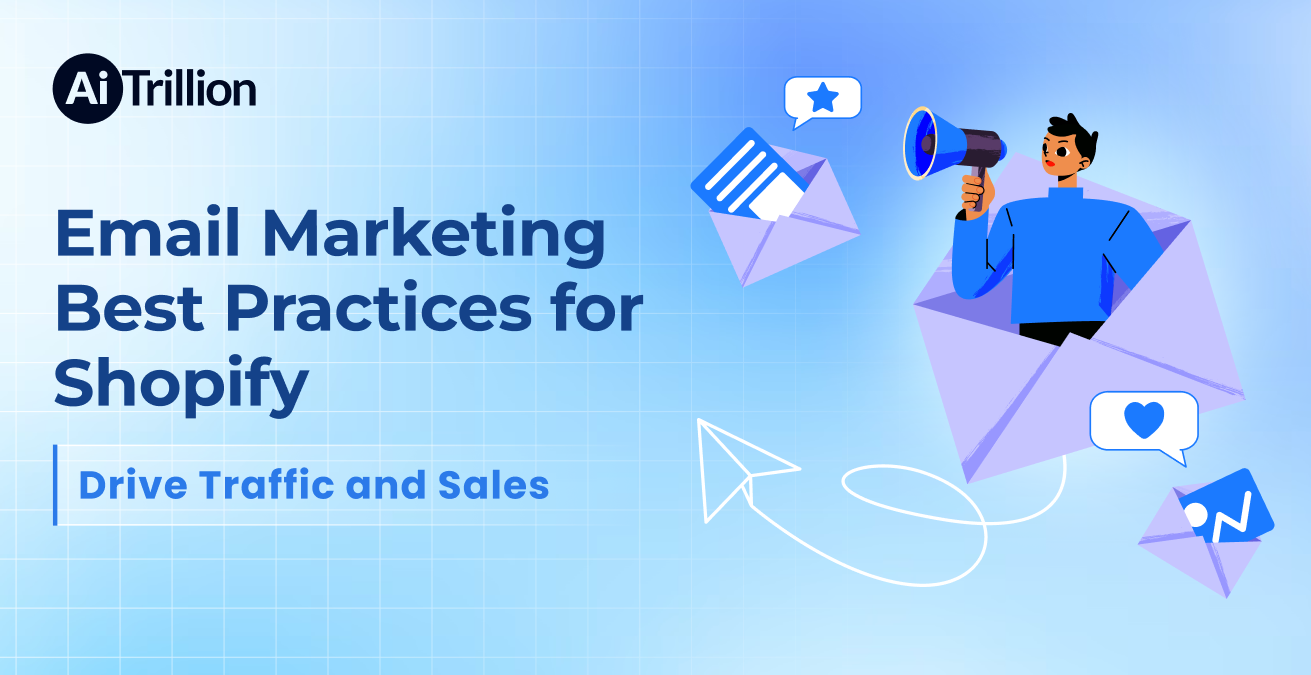
Introduction
Importance of Email Marketing for Shopify Stores
Email marketing remains a cornerstone of digital marketing strategies, particularly for e-commerce businesses like Shopify stores. Its significance lies in its ability to offer direct, personalized communication with customers, fostering relationships that can lead to increased loyalty and sales. In an environment where social media algorithms can make it challenging to consistently reach your audience, email marketing ensures that your message lands right in your customer’s inbox.
Overview of Key Benefits
- High ROI: Email marketing is known for delivering a high return on investment. According to the DMA, for every $1 spent on email marketing, the average return is $42. This makes it one of the most cost-effective marketing strategies available.
- Direct Communication: Unlike social media, where your posts can be lost in the feed, emails go directly to your customer’s inbox. This ensures that your message is seen by your audience.
- Personalization: Emails can be tailored to individual customer preferences and behaviors, increasing the relevance of your communications and improving engagement rates.
- Automation: Many email marketing tasks can be automated, saving time and resources while ensuring that your customers receive timely and relevant messages.
2. Building a High-Quality Email List
Our comprehensive Loyalty and Rewards Program turns every purchase into an opportunity for your customers to earn exciting rewards. With AiTrillion, you can create customized loyalty programs that drive repeat purchases and enhance customer engagement. Here’s how:
- Tiered Programs: Encourage higher spending by offering more points and exclusive rewards for larger purchases.
- Targeted Rewards: Motivate customers to explore new product categories, balancing your inventory and boosting average order value (AOV).
- Loyalty Nudges: Strategically remind customers about potential rewards to reduce cart abandonment.
- Double Dipping: Reward customers for social media engagement, reviews, and event participation, deepening their connection with your brand.
- Milestone & Bonus Rewards: Incentivize key actions like first purchases or referrals to drive desired behaviors.
The Apptile and AiTrillion Partnership: A Powerful Solution
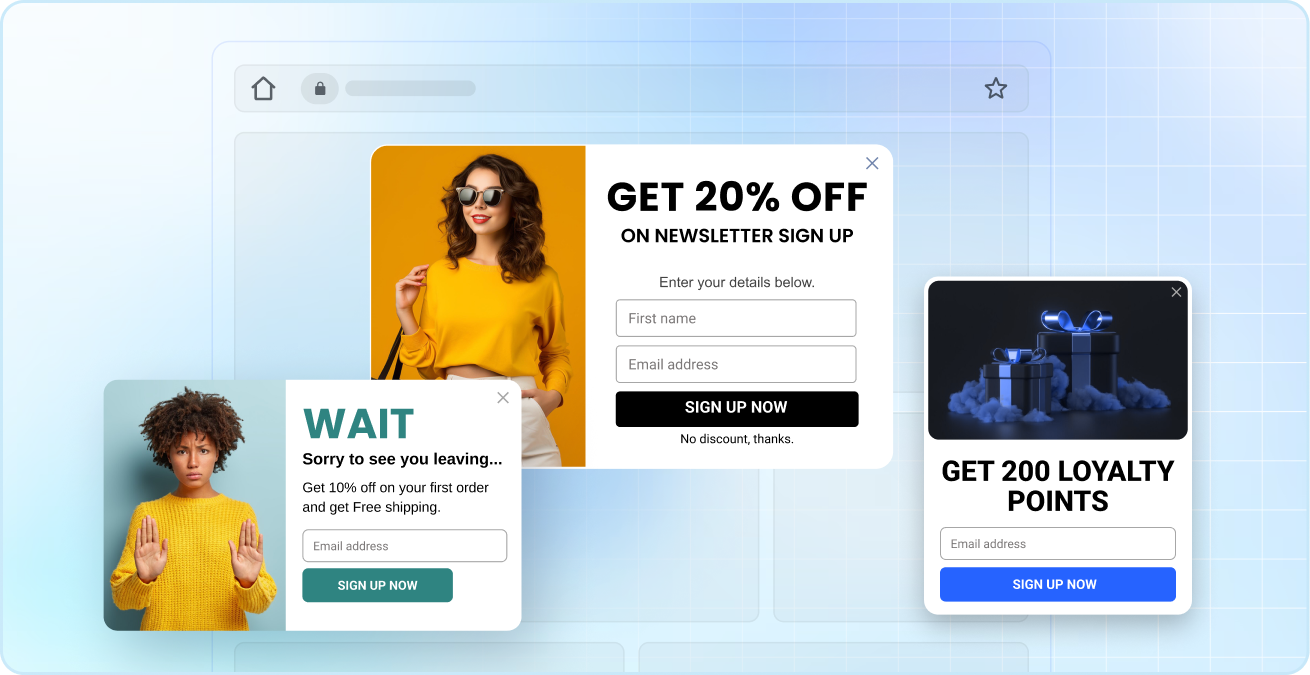
Opt-In Strategies
Building a high-quality email list is the foundation of a successful email marketing campaign. It’s not just about the quantity of subscribers but the quality. A targeted and engaged list is more likely to result in conversions. Here’s how to build a list that’s both substantial and engaged:
Effective Sign-Up Forms: Ensure your sign-up forms are easy to find and fill out. Place them in strategic locations like your homepage, blog, and checkout page. Forms should be concise and user-friendly, asking only for essential information to avoid deterring sign-ups.
Using Pop-Ups and Exit-Intent Pop-Ups: Pop-ups can be highly effective if used correctly. Exit-intent pop-ups, which appear when a user is about to leave your site, offer a last chance to capture their email. Use these sparingly to avoid annoying users.
Best Practices for Pop-Ups:
- Offer an Incentive: Provide a discount, free shipping, or a free resource in exchange for the email address.
- Clear and Concise Message: Ensure the message is straightforward and the value proposition is clear.
- Easy to Close: Users should be able to easily close the pop-up to avoid frustration and a negative user experience.
Segmentation
Segmentation is the process of dividing your email list into smaller, more targeted groups. This allows you to send more relevant messages to each group, improving engagement and conversion rates.
Why Segment Your List? Segmentation ensures that your emails are relevant to each subscriber, increasing the likelihood of engagement. By sending personalized content, you can address the specific needs and interests of different segments of your audience.
How to Segment for Maximum Impact:
- Demographic Segmentation: Group your audience by age, gender, income, and other demographic factors. This can help tailor your messaging to different life stages and income levels.
- Behavioral Segmentation: Segment based on purchasing behavior, browsing activity, email engagement, and other actions. For instance, you can target customers who have abandoned carts or those who have made multiple purchases.
- Lifecycle Segmentation: Differentiate between new subscribers, active customers, and lapsed customers. This allows you to send appropriate messages at different stages of the customer journey.
3. Crafting Compelling Email Content

Subject Lines
The subject line is the first thing your subscribers see when they receive your email. It needs to be compelling enough to encourage them to open the email.
Tips for Writing Engaging Subject Lines:
- Keep it Short and Sweet: Ideally, your subject line should be under 50 characters to ensure it’s fully visible on mobile devices.
- Use Action-Oriented Language: Create a sense of urgency or excitement with verbs and action phrases.
- Personalize When Possible: Including the recipient’s name or other personalized details can increase open rates.
- Avoid Spammy Words: Words like “free,” “buy now,” and excessive punctuation can trigger spam filters.
Examples of High-Converting Subject Lines:
- “Exclusive Offer Just for You, [Name]!”
- “Last Chance to Get 20% Off Your Favorite Items!”
- “New Arrivals You Don’t Want to Miss”
Join the 1000+ eCommerce brands that
Grow with AiTrillion everyday.
Email Body
Creating content that resonates with your audience is crucial. The body of your email should be visually appealing and contain a compelling, persuasive copy.
Creating Visually Appealing Emails:
- Professional Design: Use a clean, professional design that reflects your brand’s identity. This includes your logo, brand colors, and fonts.
- High-Quality Images: Include high-quality images and graphics that are relevant to your message. Visuals can help break up text and make your emails more engaging.
- Mobile-Friendly Layout: Ensure your email looks good on all devices by using responsive design techniques.
Writing Persuasive Copy:
- Focus on Benefits: Highlight the benefits of your products or services, not just the features. Explain how your offerings solve your customers’ problems or improve their lives.
- Clear and Concise Language: Use simple, straightforward language that’s easy to read and understand.
- Strong Call-to-Action (CTA): Include a clear and compelling CTA that tells the reader exactly what you want them to do next.
Using Personalization to Increase Engagement:
- Address the Recipient by Name: Using the recipient’s name in the email can create a more personal connection.
- Reference Past Purchases or Browsing Behavior: Tailor your recommendations based on what the customer has previously bought or viewed.
- Dynamic Content: Use dynamic content to automatically tailor parts of your email to different segments of your audience.
4. Designing Mobile-Friendly Emails
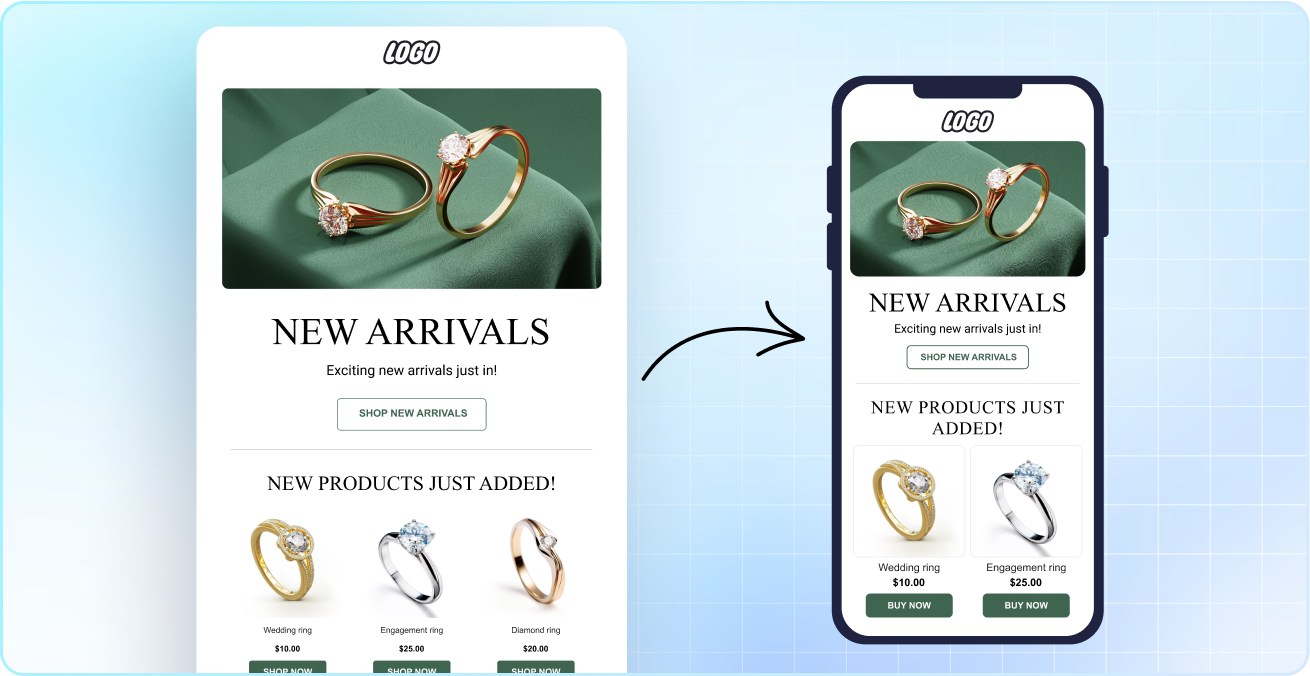
Responsive Design
With the majority of emails now being opened on mobile devices, designing mobile-friendly emails is essential.
Importance of Mobile Optimization:
- Improves User Experience: A mobile-optimized email is easier to read and interact with, leading to higher engagement rates.
- Reduces Deletion Rates: Emails that aren’t optimized for mobile are more likely to be deleted without being read.
- Maintains Professional Image: Ensuring your emails look good on all devices helps maintain your brand’s professional image.
Best Practices for Mobile-Friendly Emails:
- Single-Column Layout: Use a single-column layout to make your email easy to read on small screens.
- Legible Font Sizes: Use a font size of at least 14px for body text to ensure readability.
- Large Buttons and Links: Make buttons and links large enough to be easily tapped with a finger.
- Optimized Images: Ensure images are compressed and optimized for quick loading times.
Testing
Regular testing ensures that your emails look good and perform well across all devices.
A/B Testing for Design and Content:
- Test Different Subject Lines: Experiment with different subject lines to see which ones achieve the highest open rates.
- Test Different Images and Copy: Compare different images, layouts, and pieces of copy to determine what resonates best with your audience.
- Test Different CTAs: Try out different calls to action to see which ones generate the most clicks and conversions.
Tools and Techniques for Effective Testing:
- Email Marketing Platforms: Use platforms like Mailchimp or Klaviyo that offer A/B testing features.
- Monitor Key Metrics: Track open rates, click-through rates, conversion rates, and other key metrics to understand the effectiveness of your tests.
- Iterate Based on Results: Use the insights gained from your tests to refine and improve your email marketing strategy.
5. Automating Your Email Campaigns
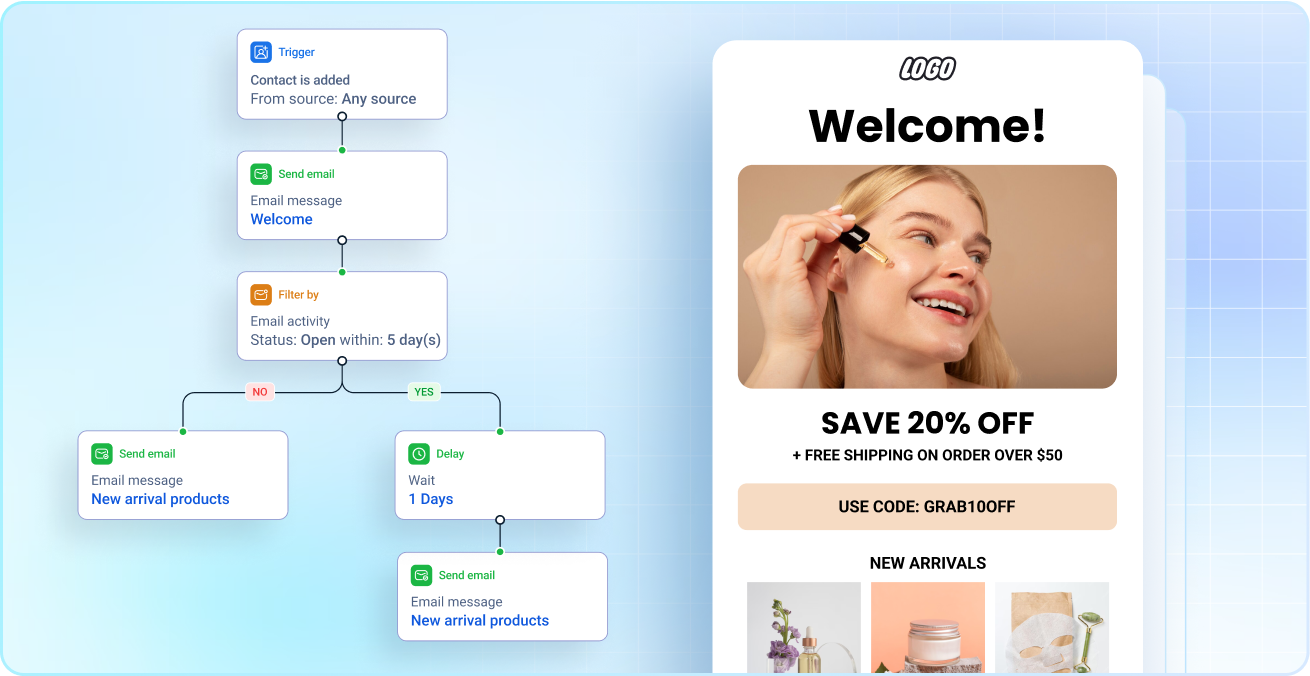
Welcome Series
Automated welcome emails are a great way to make a strong first impression. They help new subscribers get to know your brand and encourage them to make their first purchase.
Setting Up a Welcome Email Sequence:
- Immediate Welcome Email: Send a welcome email immediately after someone subscribes. This email should thank them for signing up and provide an introduction to your brand.
- Follow-Up Emails: Over the next few days or weeks, send additional emails that highlight your brand’s story, best-selling products, and any special offers.
Examples of Effective Welcome Emails:
- Friendly Greeting: Start with a friendly greeting and a thank you for subscribing.
- Brand Introduction: Introduce your brand’s story, values, and mission.
- Highlight Products: Showcase your best-selling or most popular products.
- Special Offers: Provide a discount code or special offer as a thank you for subscribing.
Join the 1000+ eCommerce brands that
Grow with AiTrillion everyday.
Abandoned Cart Emails
Abandoned cart emails can help recover lost sales by reminding customers of items they left behind and encouraging them to complete their purchases.
Crafting Abandoned Cart Email Sequences:
- First Email: Send the first email within a few hours of cart abandonment. This email should remind the customer of the items in their cart and encourage them to complete the purchase.
- Follow-Up Emails: Send a second email a day or two later, and a final reminder email with a sense of urgency or a special discount.
Strategies to Recover Lost Sales:
- Images and Descriptions: Include images and descriptions of the abandoned items to remind the customer what they left behind.
- Clear CTA: Use a clear and compelling call-to-action to encourage the customer to complete their purchase.
- Incentives: Offer an incentive, such as a discount or free shipping, to motivate the customer to complete the purchase.
Post-Purchase Follow-Up
Follow-up emails after a purchase can help build customer loyalty and encourage repeat business.
Thank You Emails and Upsell Opportunities:
- Thank You Email: Send a thank you email immediately after purchase to express gratitude and confirm the order details.
- Upsell Products: Suggest related products or accessories that the customer might be interested in.
Requesting Reviews and Referrals:
- Review Request: Ask customers to leave a review for their purchase. Positive reviews can build trust and attract new customers.
- Referral Program: Offer incentives for referrals to encourage customers to spread the word about your brand.
6. Analyzing and Optimizing Email Performance
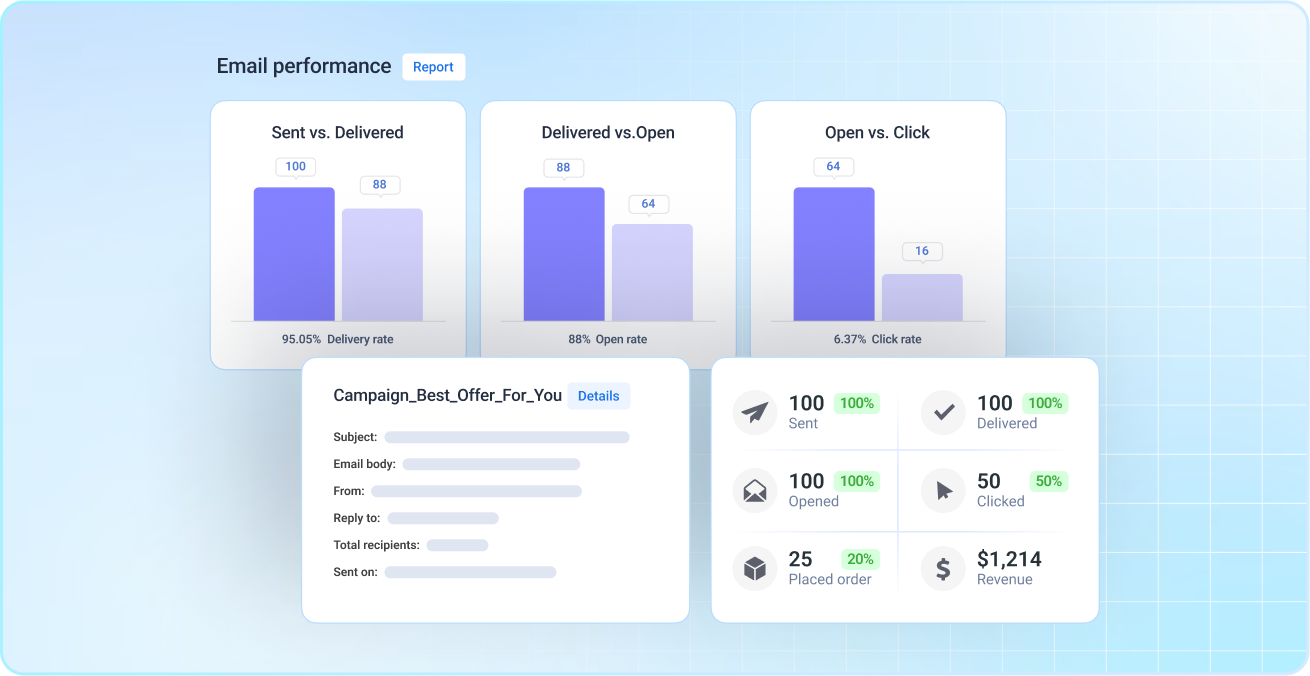
Key Metrics to Track
To understand how well your email campaigns are performing, you need to track key metrics.
- Open Rates: The percentage of recipients who open your email. A low open rate could indicate that your subject line needs work.
- Click-Through Rates (CTR): The percentage of recipients who click on a link within your email. A low CTR might suggest that your content or CTA isn’t compelling enough.
- Conversion Rates: The percentage of recipients who complete the desired action (e.g., making a purchase). This is a key indicator of your campaign’s success.
- Bounce Rates: The percentage of emails that couldn’t be delivered. A high bounce rate could indicate issues with your email list quality.
- Unsubscribe Rates: The percentage of recipients who opt out of your email list. Monitoring this can help you understand how well your content is resonating with your audience.
Continuous Improvement
Analyzing your email performance is only the first step. To achieve sustained success, you need to continuously improve your campaigns.
How to Use Data to Improve Future Campaigns:
- Identify Trends: Look for patterns in your metrics to understand what’s working and what’s not.
- Conduct A/B Tests: Compare different elements of your emails to determine the most effective strategies.
- Customer Feedback: Use feedback from your customers to make adjustments and improve your content.
Adapting Strategies Based on Performance:
- Increase Frequency of Successful Emails: If a particular type of email is performing well, consider increasing its frequency.
- Tailor Content for Low-Engagement Segments: If a segment of your audience is not engaging, try different content or offers tailored to their interests.
- Stay Updated: Keep up with email marketing trends and best practices to ensure your campaigns remain effective.
7. Integrating Email Marketing with Other Marketing Channels

Social Media
Combining email marketing with social media can amplify your reach and engagement.
Cross-Promoting Email Campaigns on Social Platforms:
- Share Email Content: Repurpose your email content for social media to reach a broader audience.
- Encourage Subscriptions: Use social media to encourage your followers to subscribe to your email list.
- Highlight Benefits: Create social media posts that highlight the benefits of subscribing to your emails, such as exclusive offers and updates.
Content Marketing
Integrating your email marketing with content marketing efforts can enhance your overall strategy.
Using Blog Posts and Content to Grow Your Email List:
- Sign-Up Forms on Blog: Include email sign-up forms on your blog and other content pages to capture leads.
- Content Upgrades: Offer downloadable guides, checklists, or other valuable resources in exchange for an email address.
- Promote Newsletter: Promote your email newsletter within your content to attract subscribers.
Loyalty Programs
Email marketing can be a powerful tool for promoting and enhancing your loyalty programs.
Leveraging Email to Boost Loyalty Program Engagement:
- Announce New Benefits: Send emails to announce new loyalty program benefits and rewards.
- Remind Points Balance: Use email to remind customers of their points balance and encourage redemption.
- Highlight Success Stories: Share success stories of loyal customers to motivate others to participate.
8. Compliance and Best Practices
Join the 1000+ eCommerce brands that
Grow with AiTrillion everyday.
GDPR and CAN-SPAM
Compliance with email marketing regulations is crucial to avoid penalties and maintain customer trust.
Understanding Email Marketing Regulations:
- GDPR (General Data Protection Regulation): Applies to businesses that collect data from EU citizens. It requires explicit consent for email marketing and provides guidelines on data protection.
- CAN-SPAM (Controlling the Assault of Non-Solicited Pornography and Marketing) Act: Regulates commercial emails in the US. It requires accurate sender information, a clear subject line, and an easy way for recipients to opt out.
Ensuring Compliance to Avoid Penalties:
- Obtain Explicit Consent: Ensure you have explicit consent from subscribers before sending emails.
- Include Unsubscribe Link: Make sure every email contains a clear and easy-to-find unsubscribe link.
- Honor Opt-Out Requests: Promptly honor opt-out requests to avoid legal issues and maintain trust.
Maintaining Deliverability
Ensuring your emails reach the inbox is essential for the success of your campaigns.
Strategies to Keep Your Emails Out of Spam Folders:
- Reputable ESP: Use a reputable email service provider (ESP) with good deliverability rates.
- Avoid Spam Triggers: Avoid using spammy language and excessive use of images or links.
- Regular List Cleaning: Regularly clean your email list to remove inactive or invalid addresses.
- Monitor Sender Reputation: Keep an eye on your sender’s reputation and address any issues promptly.
Conclusion
Recap of Best Practices
Email marketing is a powerful tool for driving traffic and sales for your Shopify store. By building a high-quality email list, crafting compelling content, designing mobile-friendly emails, automating your campaigns, and continuously analyzing and optimizing performance, you can achieve significant results.
Encouraging Continuous Learning and Adaptation
The world of email marketing is constantly evolving. Stay updated with the latest trends, tools, and best practices to keep your campaigns fresh and effective. Always be willing to test new strategies and adapt based on your findings.
Join the 1000+ eCommerce brands that
Grow with AiTrillion everyday.
By following these email marketing best practices, Shopify store owners can create engaging, effective campaigns that drive traffic, boost sales, and build lasting customer relationships. With the right approach and continuous optimization, email marketing can become a cornerstone of your e-commerce success.
Table of Contents



Leave a Comment
You must be logged in to post a comment.